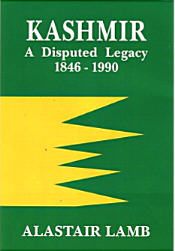
1846-1990
ISBN 0 907129 06 4 October1991, 368pages,6 maps.biblography,index,234x156mm paperback
Price £15 plus postage £2.50
The Kashmir dispute has dominated the foreign relations of the Indian subcontinent for over for decades. Not only has it guaranteed continuing Indo -Pakistani hostility but it has played a highly significant part in both the genesis and the persistence of ill will between India and China. It remains one of the major unresolved issues of the world today.
| In the first part of this book Alastair
Lamb traces the problem of the State of Jammu and Kashmir
back to the creation of that polity in 1846 when the
English East India Company sold the Vale of Kashmir to
the Raja of Jammu, Gulab Singh. From that moment the
State had a major role in the defence of the Northern
Frontier of British India against external threats which,
in the British period, were believed to originate in
Russia. This geopolitical factor guaranteed that at the
time of the British departure from their Indian Empire in
1947 serious attempts would be made to transfer the State
to India, the larger of the two successors to the British
Raj, despite the majority of the State's population being
Muslim. The events of 1947 are carefully examined; and
fresh light is cast on such questions as the role of
Mountbatten in the genesis of the dispute, the precise
sequence of events which produced the Pathan involvement,
and the manner in which the Hindu Maharaja of the State
was finally induced to throw in his lot with India. |
The consequences of India's determination to retain this strategic corner of the subcontinent are explored in detail in the second part of this book. Among the topics covered are: Indo-Pakistani armed conflict in 1947-49, 1965 and 1971; United Nations involvement; attempts at direct Indo-Pakistani negotiation; the internal politics of the State of Jammu and Kashmir and the importance of Sheikh Abdullah; the collapse of civil order in the Vale of Kashmir with the rise of insurgency in the late 1980's. The detailed narrative ends in the spring of 1990. |
| This book is the result of some thirty
years of research based on a wide range of sources; and
it provides the essential background to any understanding
of the present situation in the Vale of Kashmir. |